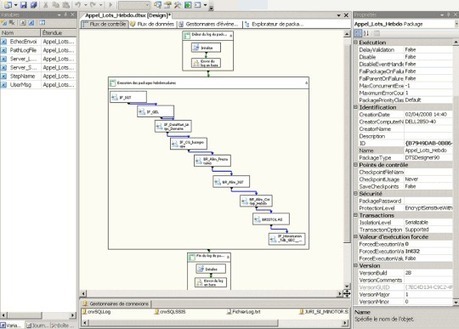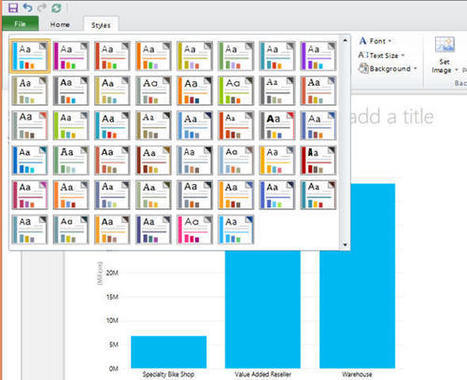 Your new post is loading...
 Your new post is loading...

|
Scooped by
Mickael Ruau
February 17, 2014 4:30 AM
|
Microsoft SQL Server Integration Services (SSIS) est un ETL (Extract, Transform, Load). Les préconisations en matière de développement varient d’une entreprise à l’autre. Cependant certaines bonnes pratiques garantissent une intégration des données et des développement facile à maintenir.

|
Scooped by
Mickael Ruau
January 16, 2014 10:28 AM
|
It is hard to believe that it was once possible to corrupt a SQL Server Database by storing perfectly normal data values into a table; but it is true. In SQL Server 2000 and before, one could inadvertently load invalid data values into certain data types via RPC calls or bulk insert methods rather than DML. In the particular case of the FLOAT data type, this meant that common ‘special values’ for this type, namely NaN (not-a-number) and +/- infinity, could be quite happily plugged into the database from an application and stored as ‘out-of-range’ values.

|
Scooped by
Mickael Ruau
October 24, 2013 7:43 AM
|
The Microsoft SQL Server 2012 System Views Map shows the key system views included in SQL Server 2012, and the relationships between them.

|
Scooped by
Mickael Ruau
October 23, 2013 3:01 AM
|
Tools to help database administrators manage the performance of Microsoft SQL Server.

|
Scooped by
Mickael Ruau
October 23, 2013 2:58 AM
|
Microsoft SQL Server family includes free Express edition, that is fully functional, however has some disappointing limitations which prevent from using it in development process. One of them is absense of profiling tools, standard SQL profiler is not included. However, now you have an ability to use express edition for tuning your system.SQL Server Express Edition Profiler provides the most of functionality standard profiler does, such as choosing events to profile, setting filters, etc. By now there are no analogue free tools.

|
Scooped by
Mickael Ruau
October 18, 2013 1:12 PM
|
Le spécialiste des disques durs à mémoire flash (SSD) propose un nouvel accélérateur au format PCI Express dédié à la base de données de Microsoft.

|
Scooped by
Mickael Ruau
October 4, 2013 6:23 AM
|
Coding and managing SQL Server code between numerous environments can be cumbersome. Everyone recognizes the need for establishing SQL Server coding best practices, but it is easier said than done. In this session we are going to review some of the source control systems on the market and provide recommendations for integrating a solution into your development processes to make your life easier.

|
Scooped by
Mickael Ruau
October 4, 2013 6:09 AM
|
In an ideal world all of our queries would be optimized before they ever make it to a production SQL Server environment, but this is not always the case. Smaller data sets, different hardware, schema differences, etc.

|
Scooped by
Mickael Ruau
October 4, 2013 6:07 AM
|
There are many tricks that can be used when you write T-SQL code. One of these is to reduce the amount of network data for each statement that occurs within your stored procedures. Every time a SQL statement is executed it returns the number of rows that were affected. By using "SET NOCOUNT ON" within your stored procedure you can shut off these messages and reduce some of the traffic.

|
Scooped by
Mickael Ruau
October 4, 2013 6:06 AM
|
Many databases are initially developed by professionals not deeply experienced in database development. In a lot of instances, an application engineer is drafted with the task of designing a table or database due to the lack of an available database resource. Unfortunately, sometimes working outside one's area of expertise can sometimes lead to making technical decisions that are later discovered to be less than optimal.

|
Scooped by
Mickael Ruau
October 4, 2013 6:04 AM
|
The Microsoft Business Intelligence stack provides several tools for analyzing data from different perspectives, in different formats and in different ways.

|
Scooped by
Mickael Ruau
October 4, 2013 5:59 AM
|
When SQL Server executes a query it uses a query plan to determine how to access data and complete the query. SQL Server offers DBAs and developers the ability to see these query plans to assist in query optimization. Without query plans it would be difficult to figure out how to tune and optimize your queries. One such version of query plans is Graphical Execution Plans which allows you to see a graphical representation of the processing steps of your query to find optimization opportunities.

|
Scooped by
Mickael Ruau
October 4, 2013 5:56 AM
|
In this tutorial we will cover some of the common issues with performance such as: deadlocksblockingmissing and unused indexesI/O bottleneckspoor query plansstatisticswait statsfragmentation We will look at basic techinques all DBAs and Developers should be aware of to make sure their database applications are performing at peak performance.
|

|
Scooped by
Mickael Ruau
February 17, 2014 4:29 AM
|
Microsoft SQL Server Integration Services (SSIS) est une plateforme conçue pour élaborer des solutions d'intégration de données très performantes, notamment des packages d'extraction, de transformation et de chargement (ETL) pour l'entreposage des données (Data Warehouse). SSIS propose des outils graphiques et des assistants permettant de créer et de déboguer des packages ; des tâches permettant de réaliser des fonctions de flux de travail comme les opérations FTP, l'exécution d'instructions SQL et l'envoi de messages électroniques ; des sources de données et des destinations permettant d'extraire et de charger des données ; des transformations permettant de nettoyer, d'agréger, de fusionner et de copier des données ; un service de gestion, le service Integration Services, permettant d'administrer l'exécution et le stockage des packages, et des API (Application Programming Interface) permettant de programmer le modèle objet Integration Services.

|
Scooped by
Mickael Ruau
November 16, 2013 3:21 PM
|
Comme l’an passé, David et moi allons participer à l’événement organisé par le GUSS , en animant: Une session commune « Dissection de 3 problèmes de performance » mardi après-midi Une session pour David « Haute disponibilité » mardi matin Nous...

|
Scooped by
Mickael Ruau
October 24, 2013 7:34 AM
|
The SQL Server 2012 Performance Dashboard Reports are Reporting Services report files designed to be used with the Custom Reports feature of SQL Server Management Studio.

|
Scooped by
Mickael Ruau
October 23, 2013 2:59 AM
|
FineBuild provides 1-click install and best-practice configuration of SQL Server 2014, SQL Server 2012, SQL Server 2008 R2, SQL Server 2008, and SQL Server 2005.
Download FineBuild and read SQL Server FineBuild QuickStart for details of setting up the install media and additional community content. Then do your first FineBuild!
There are five members of the FineBuild family: SQL2014FineBuild to install SQL Server 2014 CTP1SQL2012FineBuild to install SQL Server 2012SQL2008R2FineBuild to install SQL Server 2008 R2SQL2008FineBuild to install SQL Server 2008SQL2005FineBuild to install SQL Server 2005

|
Scooped by
Mickael Ruau
October 23, 2013 2:56 AM
|
This list will grow as I find new tools. So if you know of some not on this list do post them in the comments.

|
Scooped by
Mickael Ruau
October 4, 2013 6:24 AM
|
SQL injection is an attack in which malicious code is inserted into strings that are later passed to an instance of SQL Server for parsing and execution. Any procedure that constructs SQL statements should be reviewed for injection vulnerabilities because SQL Server will execute all syntactically valid queries that it receives. Even parameterized data can be manipulated by a skilled and determined attacker.

|
Scooped by
Mickael Ruau
October 4, 2013 6:10 AM
|
We've examined logical and physical design. Now it's time to get data out of the database. What are ways of accomplishing this?

|
Scooped by
Mickael Ruau
October 4, 2013 6:09 AM
|
We experience regular slowdowns on our MS SQL database. After analyzing the memory usage we would like to continue the root cause investigation by examining CPU bottlenecks.

|
Scooped by
Mickael Ruau
October 4, 2013 6:06 AM
|
Power View is a new tool for intuitive ad hoc SQL Server reporting which provides an interactive data exploration, visualization, and presentation experience to the business users. But how do you create these Power View reports?

|
Scooped by
Mickael Ruau
October 4, 2013 6:05 AM
|
A stored procedure is nothing more than prepared SQL code that you save so you can reuse the code over and over again. So if you think about a query that you write over and over again, instead of having to write that query each time you would save it as a stored procedure and then just call the stored procedure to execute the SQL code that you saved as part of the stored procedure. In addition to running the same SQL code over and over again you also have the ability to pass parameters to the stored procedure, so depending on what the need is the stored procedure can act accordingly based on the parameter values that were passed. Take a look through each of these topics to learn how to get started with stored procedure development for SQL Server. You can either use the outline on the left or click on the arrows to the right or below to scroll through each of these topics.

|
Scooped by
Mickael Ruau
October 4, 2013 6:03 AM
|
With every new version of SQL Server comes new and hopefully improved functionality.

|
Scooped by
Mickael Ruau
October 4, 2013 5:57 AM
|
In this tutorial we will focus on the move from MySQL to SQL Server and cover: a possible migration plan what you can fine tune as neededMS SQL Server editionsdata type and system function differenceshow to migrate your datatransactional and locking differencesbackup and recovery optionsdatabase maintenance and tuning The tutorial is designed for DBAs who are experienced with MySQL and plan to start using MS SQL Server. In this tutorial we will focus on the most important features, but I will also try to provide links for more detailed resources on each topic.
|
 Your new post is loading...
Your new post is loading...
 Your new post is loading...
Your new post is loading...






















